Intuitive Machines Nova-C Lunar Lander Gets Ready for Touchdown
Several recent lunar landing efforts have failed in the final seconds, but Intuitive Machines believes its lander is ready.
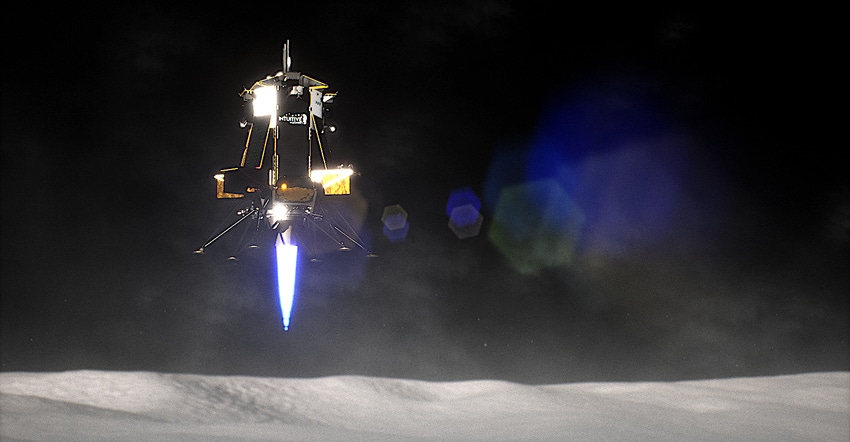
There are so many ways to crash while attempting to land on the moon. Israel, Russia, and Japan have all had landers crash on approach in recent years that lost their view of the approaching terrain, ran out of fuel, are had trouble re-firing their landing engine.
India, however, recently joined the U.S., Russia, and China among the ranks of nations that have successfully landed a vehicle on the moon’s surface. Now, Houston-based new-space startup Intuitive Machines is aiming to join them with an ambitious schedule of three planned landings by the end of 2024.
See the Apollo Lunar Rover Like Never Before
The company’s first landing mission, IM-1, could happen as soon as December, but could slip to January 2024 due to a traffic jam of scheduled launches from Pad 39A at the Kennedy Spaceflight Center, said Steve Labbe, Intuitive Machines’ vice president of engineering and manufacturing.
The Nova-C Lander
Intuitive Machines’ Nova-C lander stands 4.3 meters in height with a 1.6-meter diameter for its hexagonal hull. It weighs 675 kg and can transport 100 kg of payload. The hull is hexagonal rather than cylindrical for the practical reason of access to the interior for construction and mounting payloads, Labbe explained.
“We originally started with a cylindrical shape,” he said. “A cylinder is an extremely efficient structure. It is the easiest and best way to control the mass of the structure.” But that structure must serve the purpose of carrying payload, and the access panels that would need to be cut into the cylinder to do that would compromise its structural efficiency, he said.
“To access and mount hardware on a cylinder and have internal access, we would have to give up on the efficiency of the structure,” said Labbe. Now the spacecraft has six spines for the core structure that are attached to the top deck and the engine deck at the bottom. The six sides provide “full open access from all six directions for things like running plumbing lines and running harnesses,” he said.
Efficient wiring harness design is an underestimated detail in spacecraft construction, Labbe observed. “Routing harnesses become an important aspect of the design. You don’t want to waste even a foot of the harness because mass is the name of the game.”
Smooth Landing
Nova-C’s most significant technical achievement is its throttleable liquid methane-liquid oxygen engine. This is important for a lander because the vehicle loses mass as it burns fuel on its descent, Labbe pointed out.
Additionally, for a soft landing, it needs to be able to descend slowly for the final approach, which requires less thrust than is needed when it is approaching the surface from its 100-km orbit altitude.
“That last mile is the toughest one,” Labbe said. “That’s what everyone is finding out. It is a very challenging aspect.”
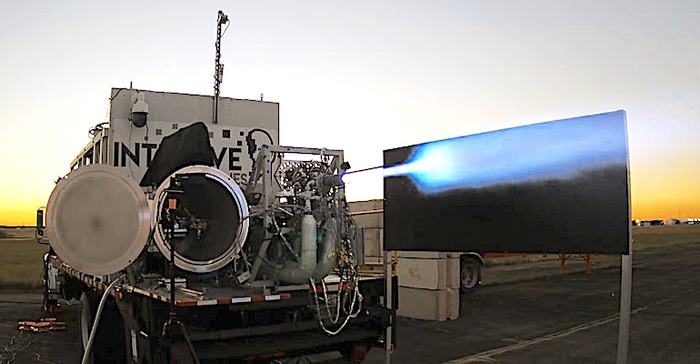
Because of the need for reduced thrust as the fuel burns off, some landers have been designed to switch their engine off and then restart it, rather than throttling it. Designing a throttleable engine is more challenging, but it avoids the potential failure of the engine to restart during descent.
“Our powered descent is done predominantly at 100 percent throttle,” Labbe explained. “Then we throttle down to a minimum thrust of 20 percent of full throttle.” The challenge is for the engine to run consistently with a stable burn while also staying within thermal margins, he said.
Real-World Testing
Intuitive Machines began testing their prototype engines very quickly after the company decided in 2019 to build a lander by applying practical solutions to the engineering requirements. “Four years ago, we knew we needed an engine,” he said.
Rather than deal with the expense and potential scheduling delays of taking prototype engines to existing rocket test stands, Intuitive Machines instead bought a giant flatbed truck and installed the necessary equipment to mount and control a rocket engine. In three months, the team was able to fire the engine on the truck by going to an airport. “We didn’t have to go to a rocket test stand where there is a high cost,” Labbe said. The company has since conducted 145 engine tests on the truck. Alas, the truck remains earthbound, despite so much time with rocket power.
In other truck-based testing, Intuitive Machines mounted its Inertia Measurement Unit and related equipment on the company’s Toyota Tundra pickup for real-world testing and calibration. “We don’t have unlimited resources,” Labbe said. “We are trying to come up with innovated ways to test our hardware.”
“We mounted our NavPods on the Tundra,” he continued. “Each one has a star tracker, IMU, and a terrain-relative camera and laser range finder. We drive around the parking lot and take images and measurements off the surface and use that data to refine those algorithms.”
The NavPods also get tested in the air. The team has mounted them on a helicopter and had it fly around the Space Shuttle landing site at Kennedy Space Center to more closely replicate the lander’s approach to the Moon.
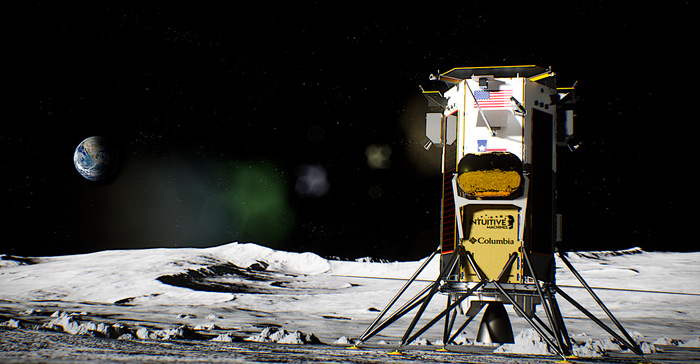
Fly Me to the Moon
Nova-C will fly to the Moon on a SpaceX Falcon 9 rocket using a direct flight with no Earth parking orbit and trans-lunar insertion as was used for the Apollo missions. This was because the Falcon 9 had the power to do a direct launch and because that initial orbit would be elongated and would cause the Nova-C to pass through the Van Allen radiation belts more than once, Labbe explained. On a direct flight, the lander will only be exposed to those high radiation levels once, on the way out from Earth.
Additionally, skipping the orbit is easier on the vehicle for other reasons. “If you some back around the Earth, you are out of the Sun for 45 minutes,” he said. During that time, the spacecraft gets very cold, and its’ solar panels are unable to provide electric power. All this weighs in favor of the simplicity of a direct launch, he said.
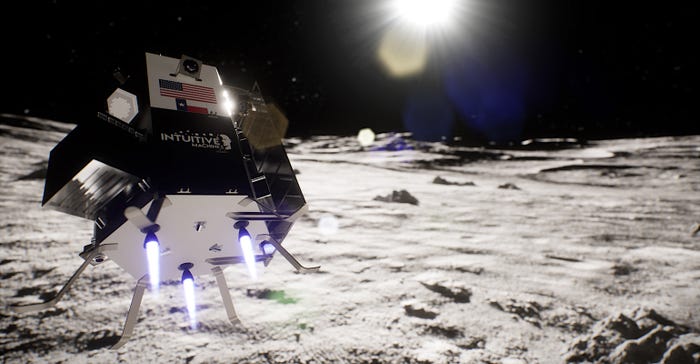
Payloads Pay the Bills
The IM-1 mission is headed to Malapert A, a satellite crater to the large 69-km Malapert that is 300 km from the Moon’s south pole. It is a candidate region for the Artemis III landing site. The NASA ROLSES (Radio Observations of the Lunar Surface photo Electron Sheath), NDL (Navigation Doppler Lidar for precise velocity and range sensing, and SCALPSS (Stereo Cameras for Lunar Plume-Surface Studies) are the main NASA payloads for IM-1. NASA is also sending the LN-1 (Lunar Note 1 navigation demonstrator) cubesat and LRA (Laser Retro-Reflective Array), which is essentially a mirror that can provide a reliable target for spacecraft to measure their location using lasers.
In addition to some commercial payloads, the IM-1 mission will also carry EagleCam, a camera system that will provide third-person imagery of the Nova-C’s landing. It was created by students at Embry-Riddle Aeronautical University, alma mater of Intuitive Machines co-founder, president, and CEO Steve Altemus. EagleCam will separate from Nova-C at an altitude of 100 feet to capture photos of the lander’s touch-down.
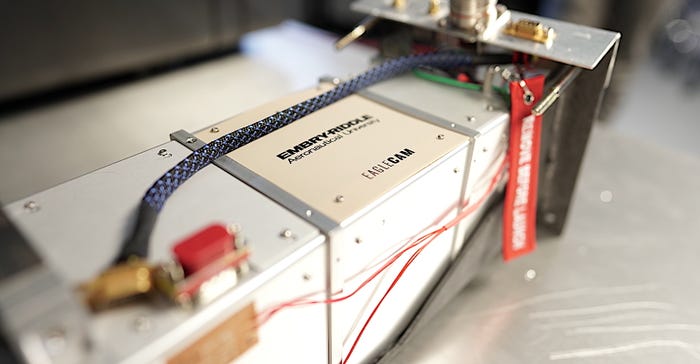
Subsequent missions will carry a large drill that will bore a meter into the Moon’s surface in search of water ice, a rocket-powered mini-lander that will hop from place to place to provide remote sensing from locations inaccessible by the Nova-C, and a rover that will carry a mini-cell tower so Nokia can test and demonstrate an LTE network on the lunar surface.
All of this sounds vaguely science-fiction-y, but speed and innovation are the benefits of new space commercial startups. Hopefully the lessons learned from other recent landing failures have provided everything Intuitive Machines needs for Nova-C to stick its landings.
About the Author(s)
You May Also Like


.jpg?width=300&auto=webp&quality=80&disable=upscale)


